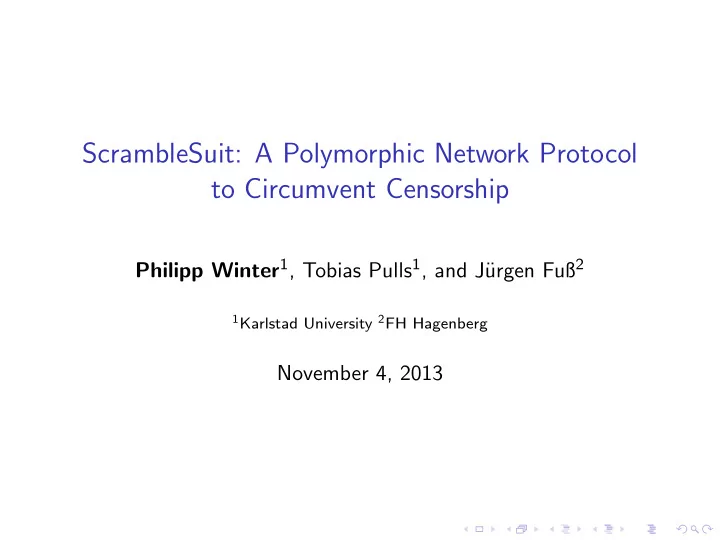

ScrambleSuit: A Polymorphic Network Protocol to Circumvent Censorship Philipp Winter 1 , Tobias Pulls 1 , and J¨ urgen Fuß 2 1 Karlstad University 2 FH Hagenberg November 4, 2013
Using Tor in China
GFW actively probes bridges!
. . . and blocks their IP:port tuple
Let’s make active probing useless!
ScrambleSuit in a nutshell ◮ Censorship-resistant polymorphic transport protocol. ◮ Relys on secret which is shared out-of-band . ◮ Disguises Tor’s flow properties. ◮ Maximise throughput while aim for acceptable level of obfuscation!
The Big Picture Other obfsproxy modules: obfs2 and obfs3 .
Thwarting active probing ◮ Client must prove knowledge of shared secret in first message . ◮ . . . otherwise, the server remains silent. ◮ Two mechanisms: Uniform Diffie-Hellman and session tickets . ◮ Session ticket is always issued after successful authentication. ◮ Bridge does not disguise aliveness!
Authenticated uniform Diffie-Hellman Client Server X || P C || M C || MAC k B ( X || P C || E ) Legend : X : public key Y || P S || M S || MAC k B ( Y || P S || E ) Y : public key Enc k t ( k t +1 || T t +1 ) P : padding M : mark handshake complete E : epoch Enc k t (Tor traffic) k : master key
Session tickets (similar to TLS) Client Server T t || P || M || MAC k t ( T t || P || E ) Legend : T : ticket Enc k t ( k t +1 || T t +1 ) P : padding M : mark handshake complete E : epoch Enc k t (Tor traffic) k : master key
How to distribute the 20-byte shared secret?
What does the shared secret look like? ◮ Base32 for easier distribution in meatspace. ◮ Example: Bridge scramblesuit 193.10.227.195:9002 password=5TYVADJINHBB67PJSBPSWVR5IO742PVO
Active probing resistance is not enough! ◮ Tor could still be identified Server−to−Client by its flow properties . �Packet Length Distribution 1.0 ◮ E.g., 586-byte signature 0.8 (512-byte cell + TLS + Empirical CDF 0.6 TCP + IP). 0.4 ◮ Maybe even inter-arrival 0.2 times. Tor 0.0 0 500 1000 1500 ◮ Our solution: A unique flow Packet length (bytes) signature for every server !
One flow signature for every server Unique PRNG random seed Frequency distributions
One flow signature for every server
One flow signature for every server
Packet length distribution ScrambleSuit ScrambleSuit Empirical CDF 0.8 Empirical CDF 0.8 Tor Tor 0.4 0.4 0.0 0.0 0 500 1000 1500 0 500 1000 1500 Packet length (bytes) Packet length (bytes) (a) Client-to-server. (b) Server-to-client.
Inter-arrival time distribution ScrambleSuit Empirical CDF 0.8 Empirical CDF 0.8 Tor 0.4 0.4 0.0 0.0 0.000 0.005 0.010 0.015 0.000 0.005 0.010 0.015 Inter arrival times (seconds) Inter arrival times (seconds) (c) Client-to-server. (d) Server-to-client.
It’s not that easy, though ◮ Strong defence against traffic analysis doesn’t come for free! ◮ We ignored “total bytes transferred” and “traffic bursts” which are expensive to disguise. ◮ (Semi-)Expensive classifiers such as VNG++ are still problematic !
How (un)practical is it? ◮ Session tickets inexpensive and 1536-bit UniformDH OK. ◮ Pure Python implementation using PyCrypto reasonably fast. ◮ Packet length obfuscation and protocol header inexpensive . ◮ Inter-arrival obfuscation expensive ! ◮ Would work in China , Syria , sometimes Iran .
Throughput Based on transferring a 1,000,000-byte file: Tor ScrambleSuit ScrambleSuit-nodelay 286 KB/s 148 KB/s 321 KB/s Goodput Overhead 19.6% 52.1% 45.5%
Want to give it a try? ◮ Code and data: http://veri.nymity.ch/scramblesuit ◮ Developed ∼ 2,600-lines prototype in Python. ◮ Will soon be deployed in pluggable transport Tor Browser Bundle.
Our first bridge is looking good
Contact E-mail: philipp.winter@kau.se Project web site: http://veri.nymity.ch/scramblesuit Thanks to : George Kadianakis Harald Lampesberger Stefan Lindskog Michael Rogers Internetfonden for research grant
Recommend
More recommend